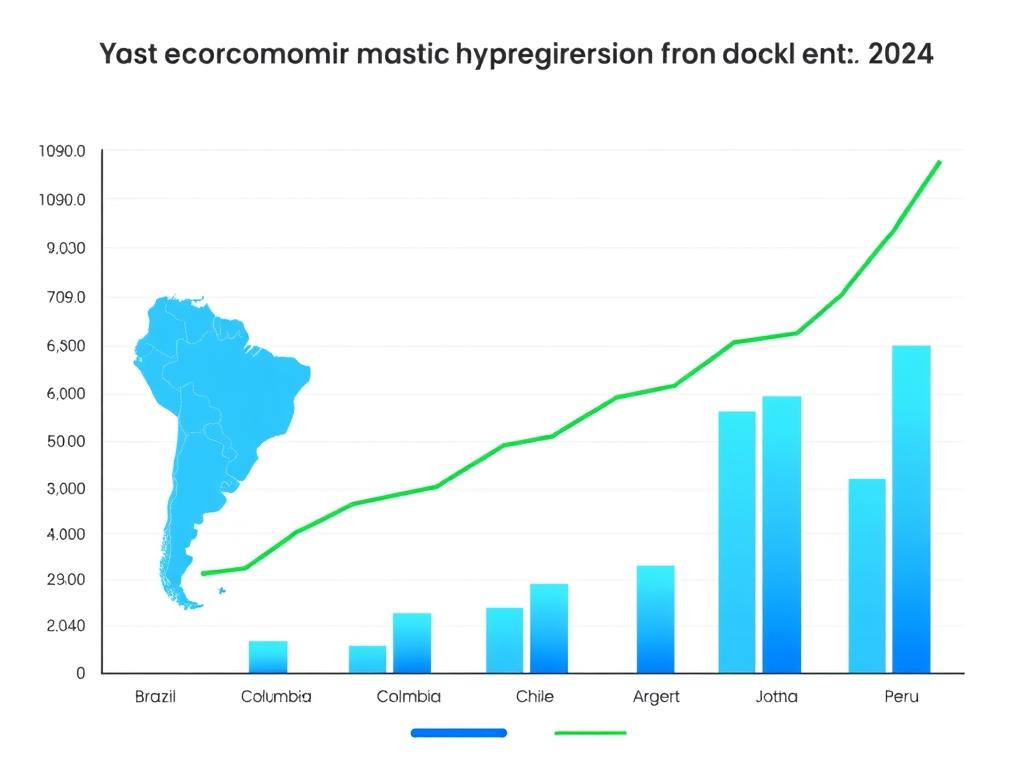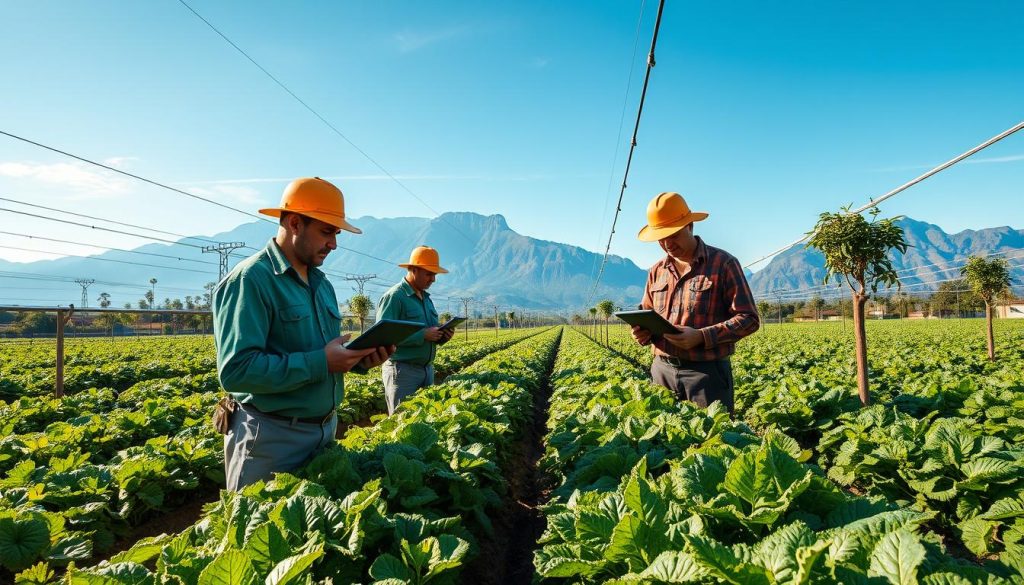South America is emerging as a hotbed of entrepreneurial opportunity, with diverse economies that offer unique advantages for business growth. From the tech hubs of Brazil and Colombia to the renewable energy potential of Chile and Argentina, the continent presents fertile ground for innovative ventures. This comprehensive guide explores the most promising business ideas in South America for 2026, backed by market insights and actionable strategies to help you capitalize on regional opportunities.
Get Your Free South American Market Entry Guide
Download our comprehensive guide with detailed market analysis, regulatory insights, and step-by-step strategies for entering South American markets successfully.
South America’s Economic Landscape: A Region of Opportunity
South America’s combined GDP of approximately $3.4 trillion represents significant economic potential, with countries like Brazil, Colombia, Chile, and Peru showing resilience and growth despite global challenges. The region is characterized by abundant natural resources, a growing middle class with increasing purchasing power, and improving digital infrastructure that’s creating new business opportunities across multiple sectors.
Key Economic Indicators
The World Bank forecasts GDP growth to rise to 2.7% by 2025 across Latin America and the Caribbean, with particularly strong performance in countries embracing digital transformation and sustainable development. Foreign direct investment is returning to pre-pandemic levels, especially in technology, renewable energy, and infrastructure projects.

Regional Integration
Cross-border commerce is accelerating through trade agreements and digital platforms, creating opportunities for businesses that can navigate multiple markets. The Pacific Alliance and Mercosur continue to reduce trade barriers, while e-commerce growth is connecting previously isolated markets and consumer segments.
“South America is transitioning from resource-dependent economies to more diversified models with significant growth in services, technology, and sustainable industries.”
Top Industries with High Growth Potential
South America offers diverse opportunities across multiple sectors. Here are the industries showing the strongest growth potential for entrepreneurs and investors in 2026:

1. Sustainable Agriculture & AgTech
South America produces 16% of global crops and 25% of the world’s beef, positioning the region as a global agricultural powerhouse. The growing demand for organic and sustainably produced food presents significant opportunities for:
- Vertical farming operations in urban centers
- Agricultural technology solutions for monitoring and optimization
- Organic food production and certification services
- Farm-to-table supply chain platforms
- Water management and efficiency solutions

2. Renewable Energy & Green Infrastructure
Renewable energy represents a rapidly growing sector, contributing 2-3% to regional GDP and providing 60% of the region’s total power. With investments hitting $186B in 2023, opportunities include:
- Solar installation and maintenance services
- Wind power development, especially in coastal regions
- Energy storage solutions and smart grid technology
- Consulting services for energy transition
- Green building materials and construction

3. Technology & Digital Services
The technology sector is transforming South American economies, with fintech alone contributing 5-6% of GDP in countries like Brazil and Mexico. Promising technology ventures include:
- Fintech solutions for the unbanked population
- E-commerce platforms specialized for local markets
- Software development outsourcing services
- Digital education and training platforms
- AI and automation solutions for traditional industries

4. Eco-Tourism & Hospitality
Tourism plays a critical role in many South American economies, accounting for over 88% of total exports in countries like St. Lucia and Grenada. The shift toward sustainable and experiential travel creates opportunities for:
- Eco-lodges and sustainable accommodation
- Cultural immersion experiences and tours
- Adventure tourism operations
- Digital platforms connecting travelers with local experiences
- Sustainable transportation services for tourists

5. Healthcare & Wellness
Healthcare needs are evolving across South America, with aging populations and increasing demand for quality services. Entrepreneurial opportunities include:
- Telemedicine and remote healthcare platforms
- Mobile medical services for underserved areas
- Wellness tourism and medical tourism facilities
- Healthcare technology and equipment distribution
- Specialized clinics and healthcare facilities

6. Critical Minerals & Sustainable Mining
South America holds vast reserves of critical minerals essential for the clean energy transition. In 2023, lithium demand surged 30%, driven by growing needs for EV batteries and renewable technologies. Business opportunities include:
- Lithium extraction and processing services
- Mining technology and equipment supply
- Environmental consulting for sustainable mining
- Reclamation and remediation services
- Supply chain management for critical minerals

7. Infrastructure Development
The region requires an estimated US$2.2 trillion in infrastructure investment by 2030, creating massive opportunities for businesses in this sector. Currently contributing 2-3% of GDP, infrastructure development is essential for economic growth. Key opportunities include:
- Road and bridge construction and maintenance
- Smart city technology implementation
- Water and sanitation system development
- Telecommunications infrastructure expansion
- Public transportation solutions
- Sustainable urban planning services
- Construction safety management
- Project management and consulting services
Emerging Business Trends in South America
Understanding the evolving business landscape is crucial for identifying viable opportunities. Here are the key trends shaping South American markets in 2026:
Digital Transformation

The rapid adoption of digital technologies is transforming traditional industries. Mobile internet penetration exceeds 70% in most South American countries, creating opportunities for digital service providers. E-commerce grew by over 30% during the pandemic and continues to expand, while fintech solutions are bringing financial services to previously unbanked populations.
Sustainability Focus

Environmental consciousness is driving business decisions across the continent. Consumers increasingly favor brands with sustainable practices, creating demand for eco-friendly products and services. Government incentives for green initiatives are accelerating the transition to sustainable business models in energy, manufacturing, and agriculture.
Cross-Border Commerce

Regional integration is facilitating easier trade between South American countries. Digital platforms are enabling small businesses to reach customers across borders. Improvements in logistics infrastructure are reducing shipping times and costs, while harmonization of regulations is simplifying compliance for businesses operating in multiple countries.
Remote Work Revolution

The global shift to remote work has created opportunities for South American entrepreneurs. Digital nomad visas and programs are attracting international talent and spending. Co-working spaces and remote work infrastructure services are expanding rapidly, while outsourcing services are growing as companies seek skilled professionals at competitive rates.
Circular Economy

Businesses focused on reducing waste and reusing materials are gaining traction. Recycling and upcycling ventures are finding innovative ways to create value from waste streams. Repair services and refurbished product markets are growing, while sharing economy platforms are enabling more efficient use of resources across various sectors.
Health & Wellness Innovation

The pandemic has accelerated interest in health and wellness products and services. Traditional South American ingredients are being incorporated into global wellness products. Mental health services and digital wellness platforms are expanding rapidly, while preventative healthcare and fitness services are seeing increased demand across demographic groups.
Stay Ahead of South American Market Trends
Our quarterly market intelligence reports provide in-depth analysis of emerging trends and opportunities across South American markets.
Success Stories: Case Studies of Thriving South American Businesses
Learning from successful ventures can provide valuable insights for your own business journey. Here are real-world examples of companies that have effectively capitalized on South American market opportunities:

Case Study 1: NotCo (Chile)
Founded in 2015 in Santiago, NotCo has revolutionized the plant-based food market using AI technology to create animal product alternatives that closely mimic the real thing.
Key Success Factors:
- Innovation: Developed proprietary AI platform “Giuseppe” to analyze plant-based ingredients and create optimal formulations
- Market Timing: Entered the market as consumer interest in plant-based alternatives was accelerating
- Strategic Partnerships: Secured distribution deals with major retailers and fast-food chains
- International Expansion: Successfully scaled from Chile to Brazil, Argentina, Mexico, and the United States
Results:
NotCo achieved unicorn status with a valuation exceeding $1.5 billion in 2021. The company has attracted investment from Jeff Bezos, Tiger Global, and Kaszek Ventures, demonstrating how South American startups can compete globally with innovative solutions to universal challenges.

Case Study 2: Rappi (Colombia)
Founded in 2015 in Bogotá, Rappi has grown from a simple food delivery app to a super-app offering everything from grocery delivery to financial services across multiple South American countries.
Key Success Factors:
- Service Diversification: Expanded beyond food delivery to offer a comprehensive ecosystem of services
- Hyperlocal Approach: Adapted services to meet specific needs in different markets
- Financial Inclusion: Integrated financial services like RappiPay to serve underbanked populations
- Logistics Innovation: Developed efficient last-mile delivery systems in challenging urban environments
Results:
Rappi operates in nine countries across Latin America and has raised over $2 billion in funding. The company employs thousands directly and provides income opportunities for over 200,000 delivery partners, demonstrating how technology can address regional infrastructure challenges while creating significant economic impact.

Case Study 3: Agrosuper (Chile)
Agrosuper has transformed from a family business into Chile’s largest food producer by embracing sustainability and vertical integration across its operations.
Key Success Factors:
- Vertical Integration: Controls the entire production chain from feed production to processing and distribution
- Sustainability Focus: Implemented comprehensive environmental management systems and renewable energy solutions
- Export Strategy: Developed strong international presence with exports to over 60 countries
- Technology Adoption: Invested in automation and digital systems to improve efficiency and traceability
Results:
Agrosuper generates annual revenues exceeding $2.5 billion and employs over 14,000 people. The company has successfully balanced growth with sustainability, reducing its carbon footprint while expanding production capacity and international market reach.
Learn From South American Success Stories
Download our detailed case studies of successful South American businesses to gain insights for your own venture.
Navigating Challenges in South American Markets
While South America offers tremendous opportunities, entrepreneurs must be prepared to address several common challenges:
Challenges
- Regulatory Complexity: Varying regulations across countries can complicate regional expansion
- Infrastructure Gaps: Underdeveloped transportation and logistics infrastructure in some areas
- Economic Volatility: Currency fluctuations and inflation risks in certain markets
- Bureaucratic Processes: Time-consuming administrative procedures for business formation
- Access to Capital: Limited venture capital and financing options compared to more developed markets
Solutions
- Local Partnerships: Collaborate with established local entities familiar with regulatory environments
- Phased Approach: Start in markets with stronger infrastructure before expanding to more challenging areas
- Financial Hedging: Implement strategies to mitigate currency and inflation risks
- Professional Services: Engage local legal and administrative experts to navigate bureaucracy
- Alternative Funding: Explore international investors, government incentives, and development bank programs
Expert Insight: Regulatory Navigation
“The regulatory landscape in South America is complex but navigable with the right approach. Successful businesses typically start by thoroughly understanding local requirements, building relationships with regulatory authorities, and maintaining flexibility in their business models to adapt to changing conditions.”
— Maria Rodriguez, International Business Consultant
Need Help Navigating South American Markets?
Schedule a consultation with our experts who specialize in helping businesses overcome regional challenges.
Market Entry Strategies for South America
Successful entry into South American markets requires careful planning and strategic approach. Here are proven strategies to consider:
| Entry Strategy | Best For | Advantages | Considerations |
| Local Partnership/Joint Venture | Businesses needing market knowledge and established networks | Reduced risk, local expertise, faster market access | Partner selection critical, potential control issues |
| Acquisition | Companies seeking rapid market entry with existing customer base | Immediate market presence, established operations | Higher initial investment, integration challenges |
| Franchise Model | Scalable business concepts with proven systems | Lower capital requirements, faster expansion | Quality control, finding qualified franchisees |
| E-commerce First | Digital products, consumer goods with low shipping costs | Test market without physical presence, lower initial investment | Logistics challenges, digital marketing requirements |
| Gradual Geographic Expansion | Businesses new to the region seeking to minimize risk | Focused resources, learning opportunities before wider expansion | Slower growth, potential competitive disadvantage |
Country Selection Considerations
Brazil

Strengths: Largest market, developed tech ecosystem, diverse economy
Challenges: Complex tax system, bureaucracy, regional differences
Best For: Technology, agriculture, renewable energy, consumer goods
Colombia

Strengths: Strategic location, growing tech scene, business-friendly reforms
Challenges: Infrastructure gaps, regional security concerns
Best For: Digital services, tourism, business process outsourcing
Chile

Strengths: Stable economy, strong institutions, free trade agreements
Challenges: Smaller market size, high concentration in Santiago
Best For: Renewable energy, mining services, export-oriented businesses
Tips for Business Success in South America
Based on the experiences of successful entrepreneurs and market experts, here are key recommendations for building a thriving business in South America:
Cultural Adaptation

- Relationship Building: Invest time in developing personal connections with partners, clients, and suppliers
- Local Adaptation: Customize products, services, and marketing to reflect local preferences and cultural nuances
- Language Consideration: While English is common in business circles, proficiency in Spanish or Portuguese significantly enhances relationships
- Community Engagement: Demonstrate commitment to local communities through meaningful corporate social responsibility initiatives
Operational Excellence

- Supply Chain Resilience: Build redundancy and flexibility into supply chains to mitigate logistical challenges
- Digital Integration: Leverage technology to streamline operations and enhance customer experience
- Talent Development: Invest in training local talent while bringing specialized expertise when needed
- Adaptive Planning: Maintain flexibility to respond to changing market conditions and regulatory environments
Financial Management

- Currency Strategy: Develop approaches to manage currency fluctuation risks
- Diverse Funding: Explore multiple funding sources including international investors, development banks, and government programs
- Tax Planning: Work with local experts to navigate complex tax environments efficiently
- Realistic Timelines: Plan for longer payback periods and account for potential bureaucratic delays
Market Expansion

- Phased Approach: Start with one market and expand gradually based on success and learning
- Regional Hubs: Establish operations in strategic locations that can serve multiple markets
- Digital Presence: Leverage online channels to test market receptivity before physical expansion
- Strategic Alliances: Partner with complementary businesses to share resources and market knowledge
“The most successful international businesses in South America are those that combine global best practices with deep local understanding. They recognize that each country has its unique characteristics while leveraging the advantages of regional integration.”
Frequently Asked Questions About Business in South America
What are the most business-friendly countries in South America?
Chile, Uruguay, and Colombia consistently rank highest for ease of doing business in South America. Chile offers strong institutions, political stability, and transparent regulations. Uruguay provides a favorable business environment with strong rule of law and low corruption. Colombia has implemented significant business-friendly reforms in recent years, particularly in reducing bureaucracy for new businesses.
How important is having a local partner when entering South American markets?
While not absolutely necessary in all cases, local partnerships significantly increase success probability in most South American markets. Local partners provide invaluable insights into regulatory environments, cultural nuances, and established business networks. They can help navigate bureaucratic processes, identify market opportunities, and avoid common pitfalls. The value of local partnerships is particularly high in markets with complex regulatory environments like Brazil and Argentina.
What financing options are available for businesses expanding to South America?
Financing options include traditional bank loans (though these often require significant collateral and established local presence), venture capital (particularly active in Brazil, Mexico, and Colombia for tech ventures), development bank programs (such as those offered by the Inter-American Development Bank), government incentives for priority sectors, and international investor networks focusing on emerging markets. Many successful ventures use a combination of these sources, often starting with international capital and gradually incorporating local financing as they establish operations.
How do I protect my intellectual property in South American markets?
Intellectual property protection varies significantly across South America. Key steps include registering trademarks, patents, and copyrights in each country where you plan to operate (not just your home country), working with specialized IP attorneys familiar with local systems, implementing robust contractual protections with partners and employees, and maintaining vigilant monitoring for potential infringements. Most South American countries are signatories to major international IP treaties, but enforcement capabilities differ substantially between countries.
Conclusion: Seizing Opportunities in South America
South America represents a dynamic and evolving business landscape with significant opportunities for entrepreneurs and investors who approach the market strategically. The region’s combination of abundant natural resources, growing middle class, digital transformation, and increasing regional integration creates favorable conditions across multiple sectors.
While challenges exist—from regulatory complexity to infrastructure gaps—they can be effectively addressed through careful planning, local partnerships, and adaptive business models. The success stories highlighted in this article demonstrate that both local and international ventures can thrive by addressing real market needs with innovative solutions.
As we look toward the future, South America’s commitment to sustainable development, technological advancement, and economic diversification suggests continued growth opportunities. Entrepreneurs who enter these markets with thorough research, cultural sensitivity, and operational flexibility will be well-positioned to build successful ventures that contribute to the region’s economic development while generating significant returns.
Ready to Explore Business Opportunities in South America?
Download our comprehensive market entry guide and schedule a personalized consultation with our regional experts.
















